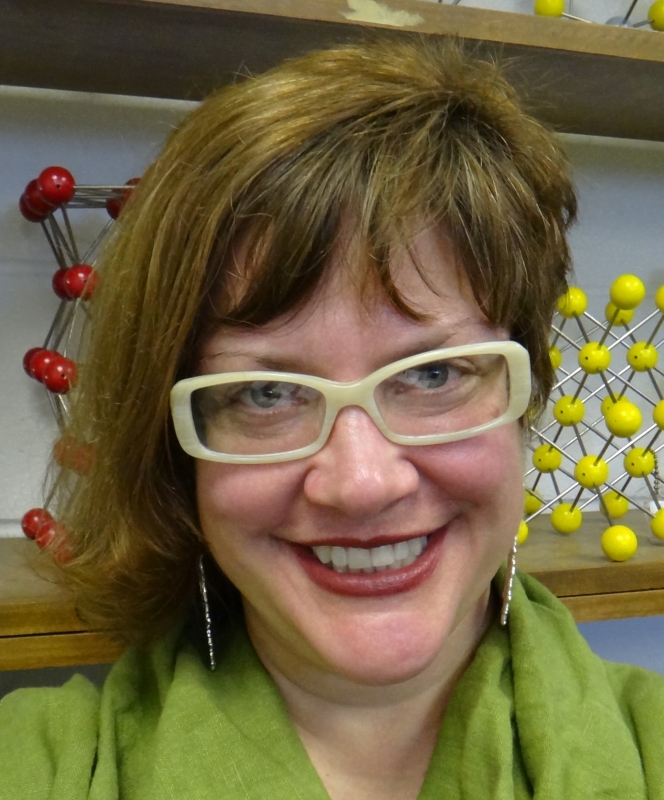Stephanie L. Brock (ag7261)
University information
Contact information
College of Liberal Arts and Sciences
Chem 145
Synthesis, properties and applications of metal pnictide and chalcogenide extended solids and nanomaterials; sol-gel nanoparticle assembly; hybrid materials
Our research efforts are centered on the synthesis and characterization of novel inorganic solid state materials with unique and tunable properties, particularly low dimensional solids and nanomaterials. The research is highly interdisciplinary, with the aim to develop a fundamental understanding of how structure, particle size, and material physical properties are related in order to advance technologies such as information storage, sensing, energy conversion and catalysis. Projects presently underway include:
I. Transition Metal Pnictide Nanoparticles: Novel Materials for Magnetic and Catalytic Applications
Transition-metal pnictides (pnicogen = Group 15 element) exhibit a wide range of magnetic and electronic properties of fundamental and practical interest including superconductivity, ferromagnetism, and semiconductivity. However, the breath of composition space plus the high degree of covalency in these systems makes production of nanoparticles as single phase, low polydispersity samples a challenge. We have developed a range of strategies for the synthesis of transition metal pnictides as nanoparticles and nanostructures, enabling formation of binary and ternary phases such as MnAs, Ni2P and Mn2-xCoxP. We have been studying the size and dopant-dependent magnetic properties of MnAs to enable potential applications in magnetic refrigeration, whereas the work on phosphides is focused on the development of new electrocatalytic materials for water splitting.
II. Sol-gel Strategies for Assembly of Metal Chalcogenide Nanoparticles into Functional Architectures
A major hurdle to the implementation of nanoparticles in solid state devices is a lack of methodologies that permit them to be assembled into functional architectures while retaining the unique, size-defined properties of the nanoparticle building block. We have shown that sol-gel strategies, long exploited for oxides, can also be used to assemble metal chalcogenide nanoparticles, including CdS, CdSe, PbS, and ZnS. The resultant gels resemble a cross-linked particulate polymeric network. This network can be dried supercritically to form low-density, highly porous aerogels. These materials combine the unique optical properties of the nanoparticle building blocks with the high surface area and electronically conducting framework of the aerogel. Currently, we are investigating the suitability of these materials for sensing, remediation, photocatalysis and photovoltaic applications.
- B.S., University of Washington, 1990
- Ph.D., University of California, Davis, 1995
- Postdoctoral Associate, University of Connecticut, 1995-1999
- Member, WSU Academy of Scholars (inducted 2020)
- WSU Outstanding Graduate Mentor Award, 2019
- American Chemical Society (ACS) Fellow, elected 201
- WSU Charles H. Gershenson Distinguished Faculty Fellowship Award, 2013-2014
- American Association for the Advancement of Science (AAAS) Fellow, elected 2012
- WSU Schaap Faculty Fellow, 2012-2017
- WSU President’s Award for Excellence in Teaching, 2010
- WSU Career Development Chair Award, 2006-2007
- WSU College of Science Teaching Award 2002
- NSF CAREER Award, 2001-2006
- Research Corporation Research Innovation Award, 2001
- S. I. Mutinda, T. N. Batugedara, B. Brown, O. Adeniran, Z.-F. Liu, S. L. Brock “Rh2P activity at a fraction of the cost? Co2-xRhxP nanoparticles as efficient electrocatalysts for the hydrogen evolution reaction in acidic media” ACS Applied Energy Materials 2021,4, 946-955. doi.org/10.1021/acsaem.0c02880
- C. C. Hewa-Rahinduwage, X. Geng, K. L. Silva, X. Niu, L. Zhang, S. L. Brock, L. Luo “Reversible Electrochemical Gelation of Metal Chalcogenide Quantum Dots” Journal of the American Chemical Society 2020, 142, 12207-12215. doi.org/10.1021/jacs.0c03156
- J. L. Davis, K. L. Silva, S. L. Brock “Exploiting Kinetics for Assembly of Multicomponent Nanoparticle Networks with Programmable Control of Heterogeneity” Chemical Communications 2020, 56, 458-461. doi.org/10.1039/C8NR09142K
- M. A. Hettiarachchi E. Abdelhamid, B. Nadgorny, S. L. Brock, “Anisotropic Manganese Antimonide Nanoparticle Formation by Solution-Solid-Solid Growth Mechanism: Consequence of Sodium Borohydride Addition Towards Reduced Surface Oxidation and Enhanced Magnetic Moment” Nanoscale, 2019, 11, 6886 – 6896. Selected for inclusion in a themed collection: International Year of the Periodic Table: As attractive as magnets—applications for magnetic materials. doi.org/10.1039/C8NR09142K
- I. K. Hewavitharana, S. L. Brock “When Ligand Exchange Leads to Ion-Exchange: Nanocrystal Facets Dictate the Outcome” ACS Nano, 2017, 11, 11217-11224. doi.org/10.1021/acsnano.7b05534
- D. Li, H. Baydoun, C. N. Verani, S. L. Brock “Efficient Water Oxidation Using CoMnP Nanoparticles” Journal of the American Chemical Society 2016, 138, 4006-4009. doi.org/10.1021/jacs.6b01543
